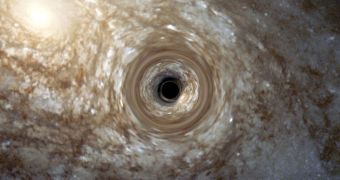A group of astronomers from the United Kingdom announces the development of a new research method that allows experts to take a closer look at the event horizon of black holes. This could help them gain more insight into the structure and development patterns governing these bodies.
Black holes are inferred to exist theoretically, in Albert Einstein's theory of general relativity, but also practically, from direct observations of the central regions of massive galaxies such as the Milky Way.
Stars in those areas have a peculiar motion that can only be explained if we take into account the possibility that a large, infinite-density object exists there, influencing the cosmic fireballs' respective orbits, Daily Galaxy reports.
Einstein proposes that these structures are points that can be found at many locations throughout the Universe, which are designed in such a manner that they distort space and time. This prevents all forms of matter and radiation from escaping their tremendous gravitational pull.
According to experts at Queen Mary, University of London (QMUL), a thorough analysis of the event horizon circling the black hole can provide a wealth of information about the structure's evolutionary stage. The method is based on the properties of the Kerr solution.
It was developed by Queen Mary's School of Mathematical Sciences professors Dr Thomas Bäckdahl and Dr Juan A. Valiente Kroon. They say that the Kerr solution is one of only a handful of solutions to the equations that Einstein formulated in the theory of general relativity.
The solution essentially describes a rotating, stationary black hole that exists independent of time. The evolution of dynamical black holes, that are also time-dependent, can be explained by this solution too.
“By looking at the region outside the black hole we have shown how to ascertain how much a dynamical black hole differs from the Kerr solution,” explains Dr Valiente Kroon, who is also an EPSRC Advanced Research Fellow.
“There are very strong indications that the end state of the evolution of a black hole is described by this solution,” the expert goes on to say.
Details of the new research appear in a study paper entitled “The ‘non-Kerrness’ of domains of outer communication of black holes and exteriors of stars. The work appears in the January 19 issue of the esteemed scientific journal Proceedings of the Royal Society A.

 14 DAY TRIAL //
14 DAY TRIAL //